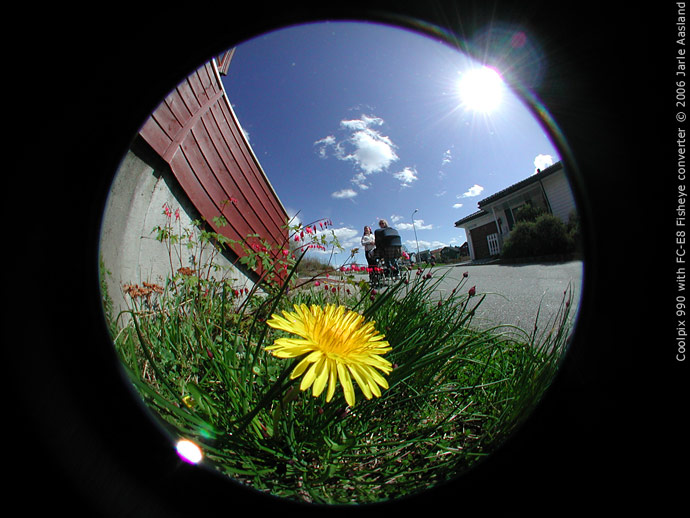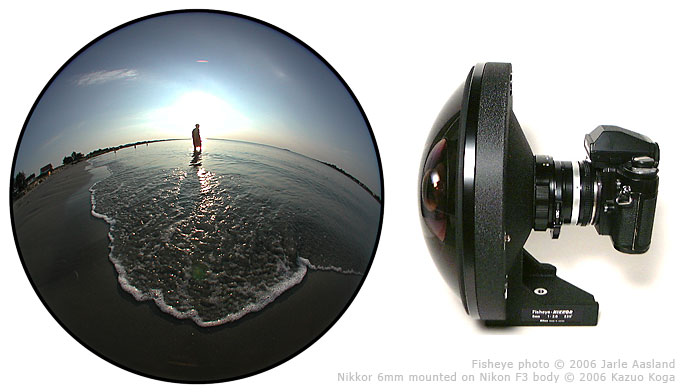Text and photos by Jarle Aasland
 Fisheyes are some of the most fun, most extreme and most challenging lenses you can work with. They can produce spectacular photos, and they can produce junk. In that respect, they're like other lenses, only more extreme.
Fisheyes are some of the most fun, most extreme and most challenging lenses you can work with. They can produce spectacular photos, and they can produce junk. In that respect, they're like other lenses, only more extreme.
I won't say much about the optical characteristics of these lenses. Reading this, you probably already know what a fisheye lens is, but here are a few quick facts: Fisheye lenses come in two flavours: Full frame and circular. Nikon pioneered the development of such lenses, releasing the World's first normal production fisheye lens (Nikkor 8mm f/8) for 35mm photography in 1962.
Since then, Nikon have made several different fisheye variants. The most common version today is the full frame 16mm f/2.8, and its DX equivalent, the 10.5mm f/2.8 (for cameras with a 1.5x crop factor). The most extreme fisheye lens is undoubtedly the impressive Nikkor 6mm f/2.8, weighing a hefty 5.2 kg. The lens was only available by special order. (See photo near bottom of page)
Fisheye lenses were first developed for scientific purposes, but soon found their way into "normal use" (whatever that is).
A classic, circular fisheye shot. A relatively mundane photo, except for the fisheye effect:

 I've used fisheye lenses before, but never owned one until I found a relatively cheap FC-E8 fisheye converter for my Coolpix 990 on a trip to Cologne, Germany, in 2001. These days you can buy these things on eBay for less than $100.
I've used fisheye lenses before, but never owned one until I found a relatively cheap FC-E8 fisheye converter for my Coolpix 990 on a trip to Cologne, Germany, in 2001. These days you can buy these things on eBay for less than $100.
Unlike ordinary SLR fisheye lenses, the converter can produce both full frame and circular images, depending on camera settings. The converter is simply screwed onto the existing, fixed lens of the Coolpix, and the fisheye settings in the camera menu will zoom the camera's lens to produce different views (circular of full frame).
The Coolpix fisheye converter is probably the easiest, and certainly the cheapest way to get circular fisheye photos from a digital camera these days. It's one of the main reasons my old Coolpix is still being used (although not as often as it used to). Optical quality is good, but obviously not perfect. Considering everything, I think the converter is well worth its price.
Alternatively, you'll need to get a full frame DSLR (a Nikon D3s or a Nikon D700, for example) and a «real» fisheye lens (one of the cheapest being Sigma's 8mm at almost $900). You can also make circular fisheye lenses work with DX-sized Nikon sensors (those with a 1.5x crop factor), but it's not for everyone, as you can see here (external link will open in new window).
A circular fisheye lens is the only thing missing in Nikon's current digital lineup (September 2006), and I guess that can be used as an argument for Nikon to develop a full frame DSLR (which I'm convinced they already are, but that's another discussion). Update: Nikon released their first full frame DSLR (Nikon D3) in August 2007, but at this time (November 2009) they do not offer a full frame fisheye lens.

When Nikon announced their new, digital 10.5mm fisheye lens in July 2003, I instantly knew I had to get one. And so I did. Shooting digital, it's both easier, cheaper and more fun to experiment, so a fisheye lens is probably a better investment today than it was in the old film days. Still, you should realize that fisheye lenses have limited use, once the novelty effect wears off (there's a limit how many funny, long-nosed portraits you can take). You should probably only get one if you have all the other equipment you need, or if you know what you are doing.
 I'm a big fisheye fan, and I'm very happy with the 10.5mm f/2.8G ED AF DX Fisheye-Nikkor (whew!). Again, it's not optically perfect, but still very, very good. I really couldn't care less if corner sharpness isn't perfect or if you see some purple fringing while staring at your monitor at 100%. This lens will capture images like no other tool in your arsenal.
I'm a big fisheye fan, and I'm very happy with the 10.5mm f/2.8G ED AF DX Fisheye-Nikkor (whew!). Again, it's not optically perfect, but still very, very good. I really couldn't care less if corner sharpness isn't perfect or if you see some purple fringing while staring at your monitor at 100%. This lens will capture images like no other tool in your arsenal.
For obvious reasons, the 10.5mm is much better than the FC-E8 converter (which is, after all, only attached to the small, existing Coolpix lens). For full frame digital fisheye photos, the Nikkor 10.5mm mounted on a 1.5x crop factor DSLR camera is the obvious choice. For a full frame camera (like D3s or D700), get the 16mm instead.
Using Nikon Capture you can even modify («defish») the 10.5mm shots to make them appear to have been taken with an ordinary, rectilinear wide-angle lens (an operation often referred to as rectilinear correction).
Consider the beach shot (the Flash animation will continously loop through 3 different steps):
In addition to the normal fisheye correction, I've also checked the «Include areas where there's no image data» option. This will produce a wider, panorama-like image, but it will also include some extra empty space on top and bottom of the image, as seen in the final step above. The black void was later cropped away, producing the final super-wide image.
 The purpose with this option is obviously to get the widest image possible. Here's some info from the Capture NX help file: «You will notice that parts of the image have been curved to transform the image into a rectilinear image. Due to the process employed by the fisheye-to-rectilinear transformation, there is more information along the longest side of the image.»
The purpose with this option is obviously to get the widest image possible. Here's some info from the Capture NX help file: «You will notice that parts of the image have been curved to transform the image into a rectilinear image. Due to the process employed by the fisheye-to-rectilinear transformation, there is more information along the longest side of the image.»
Sometimes, the fisheye-to-rectilinear option can be very useful, often it's not. If you don't want the curved fisheye effect, one could argue that you probably shouldn't use a fisheye lens in the first place. There are plenty of wide alternatives, including Nikon's own 12-24mm or the less expensive Sigma 10-20mm lenses (for DX bodies). If you want the best extreme wide angle lens for a full frame body you can buy the impressive Nikkor 12-24mm f/2.8. Often, I'm not convinced if the corrected version is better than the original, but it's nice to have the option available. In the end, it's just a matter of taste.
Here's a shot that has not been corrected:

The Manhattan skyline was captured from a moving boat, and would have been practically impossible to photograph with any other lens. This is a 1/2 second exposure - handheld. (f/2.8, 800 ISO)
Not all fisheye shots look unnatural and distorted (Coolpix 990 w/FC-E8):

The impressive Nikkor 6mm mounted on a Nikon F3 body (photos by Jarle Aasland, left, and Mr. Kazuo Koga):

Full frame fisheye lenses are great for tight action shots (Nikon D100, Nikkor 10.5mm, off-camera SB-80DX flash):

Leonardo da Vinci's «Mona Lisa» at the Louvre, Paris. Looking at the photo, it may appear like we were the only 3 people in the room. Well, we were not. The place was crowded. Nikon D100 with Nikkor 10.5mm:

Inside the Cologne Cathedral (Kölner Dom), Coolpix 990 with FC-E8:

Tourist at Times Square, New York (Nikon D2X, Nikkor 10.5mm):

Winter paradise (cropped, no rectilinear correction). Nikon D2X, Nikkor 10.5mm:


(© 2006 Jarle Aasland. Please do not distribute or use any photos on this site without prior permission).
This article was written and first published in September 2006.
- Discuss this article in the Nikon forum
- Nikon Press release: AF DX Fisheye-Nikkor 10.5mm f/2.8G ED
- Photography in Malaysia: Nikkor fisheye lenses (technical and historical data)